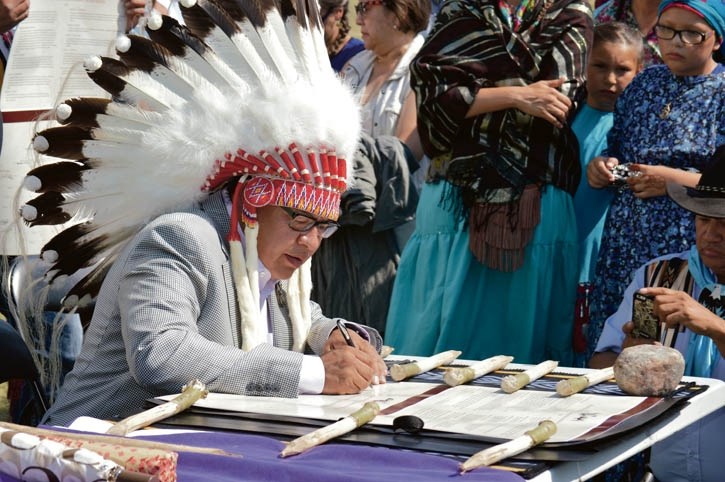A historic peace treaty signed in Banff by chiefs from northern U.S. tribes and Canadian First Nations marks a new era of unification while honouring the restoration of plains bison (buffalo) to Banff National Park.
Sacred pipe ceremonies led to the Buffalo Treaty signing at the Banff Indian Grounds on Aug. 13. Among decorated teepees, aboriginal dignitaries sat in a circle and sang traditional songs prior to the momentous signing.
The treaty recognizes cooperation and a political alliance between 10 tribes and First Nations, including Stoney Nakoda, between the bordering countries. A peace treaty of this magnitude to strengthen and renew cultural and spiritual relationships with the people, bison and lands has not occurred among these bands for over 150 years.
The treaty also highlights the importance of conservation for bison returning to traditional lands. Bison have been absent since before the park was created in 1885, mainly due to overhunting of the horned-herbivores. Bison helped shape ecosystems in North America for thousands of years.
In March, on behalf of the federal government, Banff-Airdrie MP Blake Richards announced an investment of $6.4 million over five years to restore plains bison to the flagship park as part of the National Conservation Plan (NCP). In year four of the NCP, in 2017, a small herd of 30-50 bison will be reintroduced.
Parks Canada stated the importance of bringing plains bison back for purposes including ecological restoration, inspiring diversity and a cultural connection – opening up an opportunity with First Nations peoples.
Chiniki Chief Aaron Young said the Canadian First Nations and U.S. tribes signed the treaty as a sign of respect and to support each other.
“Today’s ceremony is for buffalo, but we should recognize all First Nations. We are one and we are no different,” said Young. “Together we’ll make sure to take care of the land and take care of the buffalo.”
Chief Kurt Buffalo of the Samson Cree Nation in Maskwacis, Alta. said the signing has been long overdue and the Samson Cree have been looking into it for quite some time. He says the treaty is about relationships and economy building.
“In the legends that were told by our forefathers, when the buffalo comes back, then the First Nations will rise again, meaning economically as partners with everyone because that’s always been our intent,” said Buffalo, whose band owns Samson Mall in Lake Louise.
“As one of the most industrious nations in Alberta … it’s always about giving opportunities. For us, family is important.”
As he watched his brother sign the treaty, Councillor Kirk Buffalo said it is “extra special to be a part of this.”
The last treaty signed by the tribes, called the Lame Bull Treaty, occurred in 1855. It was made to establish a similar sense of union as the Buffalo Treaty.




